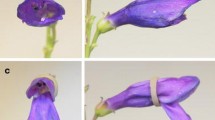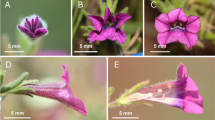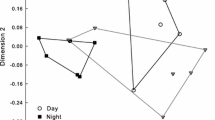Summary
Two carpenter bees (Xylocopa spp.) in southern Israel both use the asclepiad Calotropis procera as a primary nectar source. This plant genus is coevolved with carpenter bees, and aspects of the insect-flower interaction in Israel suggest that the smaller bee, X. sulcatipes, is the natural co-adapted pollinator, a view borne out by the geographical distributions of the species concerned. There are significant mismatches between the plant and the larger X. pubescens, involving physical fit and behaviour. These mismatches are particularly evident when the physiologies of the bees and the plant are considered. The different sizes and colours of the two bees lead to different daily activity patterns, only X. sulcatipes being thermally suited to, and thus abundant at, times of maximum nectar production by Calotropis. Similarly the water requirements of X. sulcatipes are finely balanced with the water production in the floral nectar; this bee gains just enough water when foraging to restore its blood concentration and production in the floral nectar; for deposition in the nest. X. pubescens does not incur net water loss in flight and gains too much water from Calotropis flowers, necessitating copious urination and ‘tonguelashing’. Hence physiological information can be of use in deciphering insect-plant coevolutionary patterns, and the water component of nectar is confirmed as a potentially major determinant of foraging activities. The circumstances where this will be particularly true, and cases where it may not apply, are discussed.
Similar content being viewed by others
References
Ben Mordechai Y, Cohen R, Gerling D, Moscowitz E (1978) The biology of Xylocopa pubescens Spinola (Hymenoptera; Anthophoridae) in Israel. Isr J Entomol 12:107–121
Bertsch A (1984) Foraging in male bumblebees (Bombus lucorum L.): maximizing energy or minimizing water load?. Oecologia 62:325–336
Calder WA (1979) On the temperature-dependency of optimal nectar concentration for birds. J Theor Biol 78:185–196
Calder WA, Hiebert SM (1983) Nectar feeding, diuresis and electrolyte replacement of hummingbirds. Physiol Zool 56:325–334
Carpenter RE (1969) Structure and function of the kidney and the water balance of desert bats. Physiol Zool 42:288–302
Chappell MA (1982) Temperature regulation of carpenter bees (Xylocopa californica) foraging in the Colorado desert of southern California. Physiol Zool 55:267–280
Chappell MA (1984) Temperature regulation and energetics of the solitary bee Centris pallida during foraging and mate competition. Physiol Zool 57:215–225
Cooper PD, Schaffer WM, Buchmann SL (1985) Temperature regulation of honey bees (Apis mellifera) foraging in the Sonoran desert. J Exp Biol 114:1–15
Corbet SA, Willmer PG (1980) Pollination of the yellow passion fruit: nectar, pollen and carpenter bees. J Agr Sci 95:655–666
Corbet SA, Willmer PG, Beament JWL, Unwin DM, Prys-Jones OE (1979) Post-secretory determinants of sugar concentration in nectar. Plant. Cell Envir 2:293–308
Feinsinger P (1983) Coevolution and pollination. In: Futuyma DJ, Slatkin M (eds) Coevolution. Sinauer, Sunderland, Mass, pp 282–310
Gerling D, Hurd PD, Hefetz A (1981) In-nest behaviour of the carpenter bee Xylocopa pubescens Spinola (Hymenoptera, Anthophoridae). J Kansas Entomol Soc 54:209–218
Gerling D, Hurd PD, Hefetz A (1983) Comparative behavioural biology of two Middle Eastern species of carpenter bees (Xylocopa Latreille) V. Smiths Contrib Zool 369
Heinrich B (1975a) Energetics of pollination. Ann Rev Ecol Syst 6:139–170
Heinrich B (1975b) Thermoregulation and flight energetics of desert insects. In: Hadley NF (ed) Environm Physiol Des Org. Dowden, Hutchinson & Ross, Stroudsberg, Pa, pp 90–105
Heinrich B (1979) Bumblebee Economics. Harvard University Press, Cambridge Mass
Heinrich B (1980) Mechanisms of body temperature regulation in honey bees. 1. Regulation of head temperature. J Exp Biol 85:61–72
Heinrich B, Raven PH (1972) Energetics and pollination ecology. Science 176:597–602
Heyneman A (1983) Optimal sugar concentration of floral nectars — dependence on nectar energy flux and pollinator foraging costs. Oecologia 60:198–213
Jaeger P (1971) Contribution à l'étude de la biologie florale des Asclepiadacées; la Calotropis procera (Ait.) Ait. Bull l'I.F.A.N. 33:32–43
Kingsolver JG, Daniel TL (1983) Mechanical determinants of nectar feeding strategy in hummingbirds: energetics, tongue morphology and licking behaviour. Oecologia 60:214–226
Lindauer M (1955) Temperaturregulierung und Wasserhaushalt im Bienenstaat. Z Vergl Physiol 36:391–432
Louw GD, Nicolson SW (1983) Thermal, energetic and nutritional considerations in the foraging and reproduction of the carpenter bee Xylocopa capitata. J Entomol Soc S.Afr 46:227–240
Michener CD (1974) The Social Behaviour of the Bees. Belknap Press, Harvard, Mass
Nicolson SW, Louw GD (1982) Simultaneous measurement of evaporative water loss, oxygen consumption and thoracic temperature during flight in a carpenter bee. J Exp Zool 222:287–296
Ohguchi O, Aoki K (1983) Effects of colony need for water on optimal food choice in honey-bees. Behav Ecol Sociobiol 12:77–84
Percival MS (1965) Floral Biology. Pergamon Press, Oxford
Ramakrishna TM, Arekal GD (1979) Pollination biology of Calotropis gigantea. Current Sci 48:212–213
Unwin DM (1980) Microclimate Measurement for Ecologists Academic Press, London
Unwin DM, Willmer PG (1978) A simple field cryoscope osmometer for freezing point determination with small fluid samples. Physiol Entomol 3:341–345
Velthuis HHW, Gerling D (1983) At the brink of sociality; interactions between adults of the carpenter bee Xylocopa pubescens Spinola Behav Ecol Sociobiol 12:209–214
Wanntrop HE (1974) Calotropis gigantea (Asclepiadaceae) and Xylocopa tenuiscapa (Hymenoptera, Apidae); studies in floral morphology and pollination biology. Sven Bot Tidskr 68:25–32
Willmer PG (1982) Microclimate and the environmental physiology of insects. Adv Ins Physiol 16:1–57
Willmer PG (1983) Thermal constraints on activity patterns in nectar-feeding insects. Ecol Entomol 8:455–469
Willmer PG (1985) Size effects of the hygrothermal balance and foraging patterns of a sphecid wasp, Cerceris arenaria. Ecol Entomol 10:469–479
Willmer PG (1986) Foraging patterns and water balance; problems of optimization for a xerophilic bee, Chalicodoma sicula. J Anim Ecol 55:941–962
Willmer PG, Corbet SA (1981) Temporal and microclimatic partitioning of the floral resources of Justicia aurea amongst a concourse of pollen vectors and nectar robbers. Oecologia 51:67–78
Willmer PG, Unwin DM (1981) Field analysis of insect heat budgets; reflectance, size and heating rates. Oecologia 50:250–255
Zohary M (1962) Plant Life in Palestine. Ronald Press, New York
Author information
Authors and Affiliations
Rights and permissions
About this article
Cite this article
Willmer, P.G. The role of insect water balance in pollination ecology: Xylocopa and Calotropis . Oecologia 76, 430–438 (1988). https://doi.org/10.1007/BF00377039
Received:
Issue Date:
DOI: https://doi.org/10.1007/BF00377039




